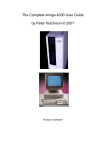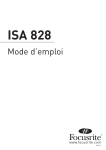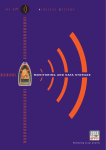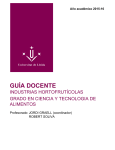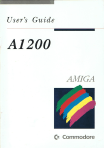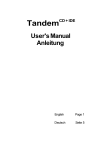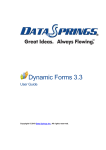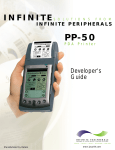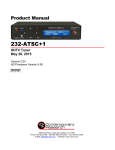Download The Complete Amiga 1200 User Guide by Peter Hutchison © 2010
Transcript
The Complete Amiga 1200 User Guide by Peter Hutchison © 2010 Revised: 16/12/2010 Contents Introduction Page 3 Setting up the Amiga for First Time Page 4 Guide to Workbench 3.0 Page 6 Menus Mouse Programs Preferences Page 6 Page 8 Page 9 Page 13 Beyond Workbench 3.0 Page 20 Adding more Memory to the A1200 Page 20 Upgrading the Processor Page 21 Upgrading Expansion on the A1200 Page 23 Upgrading the Kickstart and Workbench Page 24 The Motherboard in details Page 25 Backward Compatibility Page 26 Adding a Hard Disk to A1200 Page 27 Installing Workbench onto a Hard Disk Page 29 2 Introduction Welcome to the Commodore Amiga A1200, one of the most popular Amiga models of its time. It was affordable and easy to use. It had a wide range of software, in particular, games which Jay Minor, the creator of the Amiga, had designed it for. The Amiga A1200 is based on the Motorola 68020 14MHz Processor with 2MbRAM, a single 880K floppy drive with support for three more floppy drives and a Custom Chipset that provides the Sound and Graphics. The Amiga runs the Operating System called AmigaOS which consists of the Kickstart ROM which contains some essential libraries and devices needed to load Workbench which is the desktop: Figure 1 You can a while menu bar at the top and all the disks mounted on the right hand of the screen. The Ram Disk is a special one which is a disk in memory basically. More on Workbench will be explained later. 3 Setting up the Amiga for First Time Before setting up the Amiga make sure you have the following items ready: Amiga A1200 Monitor or TV Set Mouse Power Supply Joystick (optional) Speakers (optional) External Disk drives (optional) Withe Amiga facing you, first plug the square end of the Power Supply cable to the Power socket on the top left hand at the back of the Amiga. Plug the other end into a power socket but DO NOT switch on yet. If you have a monitor, plug the monitor cable into the Video socket, if you have a TV Set then plug it into the RF or Composite socket and also plug the power cable into a power socket. Next plug the Mouse into Port 1 of the D shaped sockets on the right-hand side at the back. Plug any Joystick onto Port 2 next to it. The stereo speakers can be plugged into the Left and Right speaker sockets in the middle at the back. The speakers can be either stand-alone ones or part of the monitor so if necessary, plug the other ends into the Left/Right sockets on the monitor. Plug in to power supply as necessary. Finally if you have any external floppy disk drives plug them in to the External Drive socket on the back of the Amiga. Further drives can be added to other drives. If you have an external hard disk, remove the cover from the Expansion port on the lefthand side of the Amiga and slot in the drive. Now switch on the power and press the power switch located on the Power Supply for the Amiga and switch on the monitor. If you do not have disks inserted you will see the Insert Disk screen below: Figure 2 4 You can then insert either a Workbench disk or any other bootable disk such as a game into the floppy drive on the right-hand side of the Amiga (called DF0: - Disk Floppy Zero). Insert your Original Workbench disk and wait for the workbench screen to appear. Before continuing, I recommend that you make one or more copies of your original Workbench disks to use rather than the Original as that can become damaged over time and you may need to make other copies later. To make a copy, get hold of a blank 880K double-density disk ready, then move the white arrow (called a pointer) with the mouse over the Workbench 3.0 disk and click the left mouse button once (this will select the disk), then move the pointer to the top left of the screen and click and HOLD the right-hand mouse button and a menu appear, make sure the Icons menu is selected, move the mouse down the menu and select Copy Figure 3 It will say ‘Put the SOURCE disk (FROM disk) in drive DF0:’, remove the disk from the floppy drive, and make sure it is your original Workbench disk, at the top there is a hole, make sure it is not covered with the black tab to protect the disk during this operation. Reinsert the disk, and with the left mouse button click once on Continue. Once the read operation is complete, it will ask you to insert the DESTINATION (TO disk) in drive DF0:. Press the eject button to remove your original Workbench disk, and insert your Blank disk (the hole should be covered on this disk). Click on Continue to write the information to your new disk. You may need to repeat the disk swap a couple of times more until the operation is completed. Now you will have a disk called ‘copy of Workbench’, you can rename this by selecting the disk, then select Rename from the Workbench menu and change it to just ‘Workbench’. You should put your original disk somewhere safe and then use your copy of Workbench from now on. Reboot with your new Workbench disk in DF0. 5 Guide to Workbench 3.0 Contents 1. The Menus 2. The Mouse 3. W B Program s 4. Am igaDOS 5. Com m on Problem s 1. The Menus At the top of the screen, there are three m enus which are accessible when you m ove the pointer to the top of the screen and click the Right Mouse Button. (RMB). Som e m enus are also accessible via keyboard shortcuts using the left Am iga key and a Letter or character (shown in brackets). 1.1 W orkbench menu 1.1.1 Backdrop (B) Turns the backdrop window on of off which surrounds the desktop. 1.1.2 Execute Com m and (E) This displays an input box where you can enter any Am igaDOS com m and or launch any W orkbench program by entering its nam e. For exam ple, typing NewShell will open a Com m and Shell window. 1.1.3 Redraw All This redraws all the icons on the desktop. 1.1.4 Update All Reload all the icons and redraw them . 1.1.5 Last Message Display the last error or inform ation m essage on the title bar. 1.1.6 About (?) Display Kickstart and W orkbench versions and Copyright inform ation. 1.1.7 Quit (Q) Exit W orkbench, this will quit workbench and leave the workbench screen open. You should open a com m and window before quitting otherwise a reboot is required. 1.2 W indow menu 1.2.1 New Drawer (N) Create a new drawer (or directory or folder) in the current window. 1.2.2 Open Parent Open the parent window of the current window. 1.2.3 Close (K) Close the current window 1.2.4 Update 6 Update icons in the current window. 1.2.5 Select Contents (A) Select all the icons in the current window. 1.2.6 Clean Up (.) Tidy up the icons into a standard left to right and top to bottom layout. 1.2.7 Snapshot 1.2.7.1 W indow Save the current window size and position in icon inform ation 1.2.7.2 All Save the window and all icon size and position inform ation in their respective icon files. 1.2.8 Show 1.2.8.1 Only Icons Displays files that have an icon file and hides all other files. 1.2.8.2 All Files Display all files in window whether or not they have an icon file or not. 1.2.9 View By 1.2.9.1 Icon Display files using Icons only. 1.2.9.2 Nam e Display files using Nam e and displays protection flags, size and date and tim e last changed. 1.2.9.3 Date Display files in date order using sam e form at as Nam e with the newest files at the top. 1.2.9.4 Size Display files in size order using sam e form at as Nam e with the sm allest files at the top. 1.3 Icons 1.3.1. Open (O) This opens or runs the currently selected file or drawer. 1.3.2 Copy (C) Copies one or m ore files and prefixes the file(s) with Copy_of_ e.g. Copy_of_MyFile 1.3.3 Renam e (R) Changes the nam e of the file. A Renam e dialogue box appears with the current nam e 1.3.4 Inform ation (I) Displays inform ation about the file, drawer or disk. Includes inform ation about the icon, type, size, com m ent and protection flags. 1.3.5 Snapshot (S) Saves the current position of file within the window. 1.3.6 Unsnapshot (U) 7 Rem oves the positioning inform ation from a file. 1.3.7 Leave Out (L) Places the file on the desktop but the file is still located in its original location. A backdrop file contains a list of files left out. 1.3.8 Put Away (P) Returns a file left on the desktop back to its original location. 1.3.9 Delete This deletes a file or drawer perm anently. It does not use the Trashcan. 1.3.10 Form at Disk Form ats or prepares a disk to be used to store files and drawers. 1.3.11 Em pty Trash Em pties the content of the Trashcan folder on the boot disk. 1.4 Tools 1.4.1 ResetW B Reloads W orkbench and redraws the screen 2. The Mouse On the Am iga m ouse there are two buttons: the Left Mouse Button (LMB) and the Right Mouse Button (RMB). Moving the m ouse will m ove the arrow or pointer on the screen. 2.1 Using the Right Mouse Button To use the m enus, press down the RMB and m ove the pointer to the title bar at the top of the screen. Move the pointer over one of the m enu nam es and som e m enu item s will appear. Now, still with the RMB pressed, m ove the pointer down to the selected m enu item and release the RMB to select that item . 2.2 Using the Left Mouse Button This button is m ainly used to select and m ove icons around and click on gadgets (or buttons). 8 2.2.1 Clicking To select an icon, m ove the pointer over the desired icon and then click the LMB once. The icon will change to a reverse or an alternative im age to indicate it has been selected. W hen using gadgets such as those on windows (there are four gadgets on a window: Close, W indow-to-Front, W indow-to-Back and Resize) m ove the pointer over the desired gadget and click once to use that gadget. The gadget will change briefly and also change the window. 2.2.2 Double-Clicking This is som etim es a tricky technique to use and requires a steady hand. This m ethod is used to open disks, drawers and files or run program s. To do this, m ove the pointer over the desired icon and in quick succession (without m oving the pointer) click on the LMB twice. This should open the icon. 2.2.3 Dragging This technique allows you to m ove objects such as icons around the screen or resize windows. Select an icon with a single click, now keep the LMB down and m ove the pointer, the icon will now be dragged with the pointer. If you let go of the pointer the icon will be dropped into its new position. 2.2.4 Multiple selection You can select m ore than one icon at a tim e. To do this, click on the first icon, press the SHIFT key down (either one) and then click on the second, third, fourth icons etc. to select m ultiple icons. You can also select a whole group of icons by pressing the LMB at the top left of the icons and while keeping the LMB down m oving the pointer towards the bottom right. An expanding box will appear and the icons with in it will be selected. 3. The Programs Here I will give a brief explanation of the program s provided with W orkbench 1.3. 3.1 W orkbench Disk 3.1.1 Utilities Drawer 3.1.1.1 Clock This displays an analogue or digital clock showing the present tim e and/or date. From the m enu you can select Analog, Digital 1 or Digital 2 (difference being is that one displays tim e in a window, the other displays tim e in the window bar). You can also set the m ode (12 or 24 hour), display seconds or not, 9 the date and whether to set an alarm for som ething. 3.1.1.2 Multiview This program can view pictures, anim ations, sound and other docum ents using W orkbench’s Datatype library which can be expanded to any num ber of file form ats from basic ILBM, 8SVX, Am igaGuide, FTXT, ANIM and CDXL to m odern types such as GIF, JPEG, PNG, BMP, W ave, Mpeg and other form ats. Datatypes can be downloaded from the internet and installed. You can run the program and then open a file from the file dialogue box, if the file has an Icon file you can set its Default Tool to use Multiview to open and view the file autom atically or you can click on the file, press shift and double click on Multiview to view the file with Multiview. 3.1.1.3 More This program can be used from the com m and line to view text files with page breaks between screen’s worth of text. 3.2 Tools Drawer 3.2.1 Calculator Here is a sim ple calculator, you can press the buttons to enter values or use the keypad. The sym bols are CA (Cancel All), CE (Cancel Entry), * (Multiply), / (Divide), + (Add), - (Subtract), . (Decim al point), <(Backspace), +- (Change sign), = (Equals) The Calculator Tape window can display equations as you enter them , useful for long calculations. 3.2.2 CMD The CMD program is useful if you wish to redirect printing to a file. Run this program before printing and any output will be sent to RAM:cm d_file. Additional options can be set in the Tool types including: DEVICE = parallel or serial FILE = location of file output SKIP = skip flag MULTIPLE = store m ultiple prints NOTIFY = notify flag 3.2.3 GraphicDum p GraphicDum p can be used to print pictures to a printer. This is m ainly for IFF ILBM pictures, use Multiview for other form ats. Picture size can be set using SIZE Tool Type. 3.2.4 IconEdit IconEdit is used to m odify file icon or .info files on the Am iga. Most W orkbench 3.x icons are 4 colour icons but can be expanded to m ulticolour icons via the Extras, Color Palette m enu. You have the m ain drawing area on the left. In the m iddle you have the currently selected Colour (black in this case), the 10 colour palette below and the drawing tools: freehand drawing, curves, circles (outline or filled), rectangles (outlined or filled), straight lines and the fill tool. Each icon has two im ages, norm al and selected, selected icons are used when a user selects an icon, and it usually displays a depressed icon rather than a raised icon (the shadow around the edge m akes the difference). 3.2.5 KeyShow This displays a graphical representation of the keyboard on the screen with the characters that each key represents including those when Ctrl, Shift or Alt is pressed. Pressing any of the keys does not enter characters in to applications unfortunately. 3.2.6 InitPrinter This will initialise any attached printer with the printer’s initialisation com m and using the currently selected driver in the Printer preferences. 3.2.7 Lacer This program will toggle between interlaced and non-interlaced screen m odes. Used prim arily for video recording and genlocking. 3.2.8 Printfiles This program allows you to print text files from W orkbench. To use it to select the files you wish to print (use Shift key when selecting m ultiple files), then hold down shift and click Printfiles to print them . Use the tool type FLAGS=form feed or FORMFEED=true if you want files to start on a new page. 3.2.9 Prepcard This tool is used to prepare PCMCIA m em ory cards as static RAM cards or system m em ory. A Ram Card can hold files like a norm al disk and is accessed via the device CC0:, cards prepared as system m em ory is added to both Chip and Fast m em ory, you need to reboot before you can use that m em ory. 3.3.0 Mem acs Mem acs or MicroEm acs is a full screen text editor which allows you to write short docum ents, script files and program files if necessary. The figure below shows Mem acs with s:startup-sequence file loaded for editing. 11 3.3.1 ShowConfig This program displays system configuration about your Am iga including: a) Processor m ake and m odel b) Custom Chip set versions c) RAM type and sizes d) Expansion boards 3.3 Com m odities Drawer 3.3.1 Exchange This program lists the com m odity program s in m em ory and can control com m odities by displaying com m odity options, end a com m odity and so on. 3.3.2 ClickToFront This allows users to click anywhere in a window and click to bring it to the front of other windows without having to use the window gadgets. By default the ALT key needs to be pressed before clicking a window (this can be changed). Move it to the Startup drawer to autorun it on boot up. 3.3.3 MouseBlanker This will blank the m ouse pointer if not in use. 3.3.4 AutoPoint This allows you to select a window by just m oving the m ouse pointer over it and does not require a click to activate it. 3.3.5 Fkey This program assigns text strings to function keys and it is useful for Shell users. Up to 20 possible m acros can be program m ed. Special characters can be used: \n Return \r Return \t Tab \0 Zero <key> Key com bination eg Shift+Letter 3.3.6 NoCapsLock This disables the Caps Lock key so you will need to use Shift for Capital letters. 3.3.7 Blanker This program will blank the screen after 60 seconds of inactivity. 3.3.8 CrossDos 12 This is part of the PC Disk driver and this com m odity controls text file options for Text Filtering and Text Translation. The DosDrivers for PC0 and PC1 need to be loaded. 3.4 Prefs W orkbench can be custom ised using Preference program s in the Prefs drawer. You can select Save to save changes and will be loaded when rebooted or clicking Use will save preferences in m em ory only and will be lost on next reboot. 3.4.1 Font This selects the default fonts for W orkbench Icon Text, System default text and Screen text. 3.4.2 Locale This sets the current language, country and tim e zone inform ation. 3.4.3 Pointer This preference can be used to change the shape of the m ouse pointer. The Pointer can be a Low Res or High Res pointer depending on screen resolution. The ‘Set Point’ button determ ines where in the im age the click point is, by default it is at the top left. 13 3.4.4 PrinterPS This preference set the options for PostScript printers. Driver Mode: Postscript, Pass Through Copies: 1 to 99 Paper Form at: US Letter, US Legal, DIN A4, Custom Text Options: Font, Pitch, Orientation, Tab Text Dim ensions: Margins, Point Size, Leading, LPI, LPP Graphics Options: Margins, Im age, Shading, Dithering Graphics Scaling: Aspect, Scaling, Centering, 3.4.5 Sound This preference can change preference for sounds when W orkbench has an error. You have the option of Flashing the Display (ideal for those hard of hearing), or creating a sound either with a Beep or a Sam pled Sound. 3.4.5 Icontrol Intuition control specifies preferences for key to use for W indow Drag and enable options for Screen Menu Snap, Text Gadget Filter, Avoid Flicker and Mode Prom otion. 14 3.4.6 Overscan Overscan sets the physical screen size, the m onitor driver is loaded on the left and list of dim ensions are shown and two buttons which can be used to resize the display for Text or Graphic displays by dragging one or m ore of the nine black handles to the desired size. 3.4.7 Printer The Printer preference selects the printer driver (from Devs:Printers) and sets other options: Printer Port: Parallel, Serial Print Pitch: Pica, Elite, Fine. Print Spacing: 6, 8 LPI Print Quality: Draft, Letter Paper Type: Continuous, Single Paper Form at: Narrow tractor, W ide tractor, Custom , DIN A4, US Letter, US Legal Paper Length Left and Right Margins 3.4.8 ScreenMode This preference sets the m onitor driver and resolution and colours depth for the W orkbench screen. 15 3.4.9 Tim e This sets the current date and tim e and saves in a battery-backed clock (if provided) and in m em ory. 3.4.10 Input Input controls certain aspects of the keyboard and the Mouse: Mouse Speed - How fast the pointer m oves around the screen. Acceleration - Boosts m ouse speed when you m ove it around. Double-click delay - Delay between clicks before it’s accepted as a double click. You can use the Show and Test double-click buttons below to check in. Key Repeat Delay - Delay before a pressed key becom es repeated again. Key Repeat Rate - Determ ines how often a key is repeated on the screen. Keyboard test - Test repeat settings. Keyboard Type - Shows which keyboard m apping is used. Can be changed using SetKeyboard com m and in startup files. 16 3.4.11 Palette This preference allows you to change the default colours (shown at the top left) with new colours using either the colour wheel or the RGB sliders underneath for m ore fine control. The list of entries on the right determ ines which colour is used for what purpose, so you could use Blue or Green for text instead of Black. The Show Sam ple button brings up a dem o window with the new colours in use before you are ready to Save or Use them . 3.4.12 PrinterGfx Printer Graphics preference sets options for when printing pictures or diagram s using a printer (See Printer preferences). Dithering: Ordered, Halftone, Floyd-Steinburg Scaling: Fraction, Integer 17 Im age: Positive, Negative Aspect: Horizontal, Vertical Shade: Black & W rite, Grey Scale 1 or 2, Colour Threshold: Determ ines the colours on the screen are printed as black and white. Density: Determ ines the resolution in DPI of the output Color Correction: Corrects colour by reducing num ber of colours available to correct RGB im balances Left Edge: How far from the left edge the output starts Lim its: Determ ines paper edge lim its. Can be Ignore, Bounded, Absolute, Pixels, Multiply Sm oothing: Sm ooths diagonal lines by certain dithering techniques (except Floyd-Steinburg) Center Picture: Centres picture in the m iddle of the page. 18 3.4.13 Serial The Serial preferences control com m unications through the serial port with the following settings: Input Buffer Size: Size of the buffer in bytes to store data Baud Rate: Speed of com m unication in bites/sec. Handshaking: XON/XOFF (Software), RTS/CTS (Hardware) or None Parity: Num ber or type of bits used for error checking Bits/Char: Num ber of bits used for data Stop bits: Num ber of bits used at the end of data 3.4.14 W BPattern W orkbench pattern preferences can display specific patterns or pictures to custom ize your W orkbench desktop. Placem ent: W orkbench, W indows, Screen Type: Pattern, Picture Select Picture: Select a picture to use on the workbench Presets: Predeterm ined patterns to use. You can create your own patterns in the em pty box on the right and select which colours to use. Test: Tests your pattern or picture. 19 Beyond W orkbench 3.0 W orkbench has been upgraded three tim es since 3.0: 3.1, 3.5 and 3.9. W orkbench 3.5 and 3.9 have enhanced W orkbench a lot and com e on CD, they include: • Multim edia Program s • W eb browser i.e Aweb • Genesis for Internet and network access • Am idock for program start bar • W arp OS 5.0 for PowerPc support • Iom ega Tools for Zip and Jaz disks • New Powerful shell • Autom atic datatype recognition • Integrated unpacker (unarc) • Fast search for files • New picture datatype • Many m ore tools • HTML docum entation If W orkbench is too lim iting, you can replace the entire workbench with a replacem ent such as Directory Opus 6 which has a feature rich interface with m ore custom isation than before and m uch easier to use. There are m any m ore libraries and program s too num erous to m ention which can enhance the W orkbench experience. Check out http://www.am inet.com for them . Adding m ore Mem ory to the A1200 The Am iga m em ory is split into Chip RAM (m em ory used by the custom chipset to store graphics and sound) and Fast RAM (m em ory which is used only by the Processor). The Am iga A1200 com es with 2MB of Chip m em ory. You can increase RAM by adding m em ory via a new m em ory board into the expansion slot underneath the Am iga behind a trapdoor or via the PCMCIA slot using a m em ory card on the left hand side although this is slower than m ain m em ory due to 16bit m em ory bandwidth. Additionally, m em ory can be added via a processor accelerator card, typically up to 32MB of Fast m em ory. See docum entation with a board or device on how to install extra m em ory. 20 Upgrading the Processor The standard 68020 14MHz processor in the Am iga A1200 is quite slow com pared to m ore recent processors and cannot cope with bigger applications and gam es. The processor is slotted on the m ain m other board. For faster processors such as the 68030, 68040 or 68060 then a new expansion board needs to be purchased and inserted via the trapdoor expansion slot underneath the Am iga. Typical boards include: 1. 68020 Accelerators Blizzard 1204 or 1220/4 Has a 28MHz 68020 processor with optional FPU and Up to 8MB RAM. M-Tec T1230/28 RTC Has a 28MHz 68020 processor with 1 SIMM Slot, optional FPU and SCSI-II card. 2. 68030 Accelerators Apollo 68030 Has a 25, 33 or 50MHz 68030 processor and room for a FPU. One SIMM slot for Up to 64MB of Mem ory. Blizzard 1230-II Has a 68030 40 or 50MHz processor, optional FPU, Up to 64MB RAM in 2 SIMM slots and optional SCSI-II card. Blizzard 1230-IV Has a 50MHz 68030 processor and room for a FPU. One SIMM slot for Up to 128MB of Mem ory. Inbuilt MMU. Optional SCSI II card with 2nd SIMM slot. CSA 12-Gauge Includes a 68030 50MHz processor with m ax of 32MB of RAM. Optional non-DMA SCSI card. GVP 1230-II Uses a 40/50MHz 68030 with 2 SIMM slots for GVP RAM only, 32MB RAM. Optional SCSI card. Magnum 68030 Has a 40MHz 68030 processor and room for FPU. Up to 32MB of RAM can be added and there is an optional SCSI II card. Microbiotics MBX1230 Has a 33MHz 68030 processor with one SIMM slot for Up to 128MB RAM, optional SCSI card. (Not auto-configuring) Paravision MBX Uses a 28/33/50MHz 68030 with one SIMM slot for Up to 32MB RAM. SCSI option. (Not autoconfiguring) 21 Typhoon 030 Uses a 40MHz 68030, optional FPU and optional SCSI. Com es with 8MB Fast RAM, up gradable to 64Mb using SIMMs. Has battery backed clock and 50 pin SCSI connector. The 'Lite' version does not include FPU or SCSI port. Viper MkII Has a 40MHz 68030 EC processor and room for a FPU. One or two SIMM slots for Up to 64MB of Mem ory. No MMU. 3. 68040 Accelerators Apollo 68040 Has a 28,33 or 40MHz 68040 processor. One SIMM slot for Up to 32MB RAM. Optional 2nd SIMM (32MB) in a tower unit only and optional SCSI II card. Blizzard 1240D Desktop 1240 card. Uses 40Mhz 040, Up to 128Mb RAM and optional SCSI-2 controller. Blizzard 1240/TERC Has a 68040 but due to heat problem s it was designed for Towered A1200s. DKB 1240 Cobra Has a 40MHz 68040 with one SIMM slot for Up to 128MB RAM. Optional SCSI-II card. Magnum 68040 Has a 25 or 40Mhz 68040 processor. Up to 32MB of RAM and optional SCSI II card. 4. 68060 Accelerators Apollo 1260 Uses a 50/66/75Mhz 68060. Blizzard 1260 Uses a 50Mhz 68060. Optional SCSI interface with 2nd SIMM slot (sam e SCSI interface as the one for the Blizzard 1230-IV). Magnum 68060. Has a 50/66Mhz 68060. Upto 32MB of RAM. Optional SCSI-II interface. 5. Pow erPC Accelerators All of these are dual-processor boards and com e with 68040 or 68060 to run the OS functions. Blizzard 603e PPC Includes PowerPC 603e at 160/200/240MHz. No SCSI. Upto 128MB of RAM per slot with two SIMM slots. The plus (+) version includes SCSI interface. 22 Upgrading Expansion on the A1200 The A1200 com es with a single slot in the trapdoor. This can be used to expand the A1200 m uch further due to its Zorro II 32 bit type expansion. This has lead to adding m em ory or accelerator cards and Zorro/PCI bus boards which allow even m ore cards to be added if the A1200 was fitted into a tower case. The bus board allows users to use industry standard PCI cards with their A1200 such as graphics cards, network cards, SCSI and USB cards as long as an Am igaOS driver is available. Elbox Mediator PCI 1200 SX A bus board with six PCI slots Elbox Mediator PCI 1200 LT4 A bus board with four PCI slots Elbox Mediator PCI 1200 ZIV A bus board with four PCI slots and Zorro bus board. DCE G-Rex 1200 PCI A bus board which supports six PCI slots. ThIs requires a PPC accelerator. Micronik PCI A1200 A bus board that supports five ZorroII slots, two ISA slots and two PCI slots. 23 Upgrading the Kickstart and W orkbench The Am iga A1200 can be upgraded to latest Kickstart and W orkbench as follows: From To Requirem ents W orkbench 3.0 W orkbench 3.1 Kickstart 3.1 W orkbench 3.0 or 3.1 W orkbench 3.5 / 3.9 Kickstart 3.1, 6M RAM, 68020 processor, Hard Disk, CD ROM In m ost cases a new Kickstart ROM Chip set needs to be installed. You can also replace the old OCS chips with ECS (Enhanced Chip Set) but you cannot install AGA Chip Set. Instructions 1. 2. 3. 4. 5. 6. 7. 8. 9. Place the A1200 unit upside down on a flat surface. Use a screwdriver to rem ove the five case screws. Turn the unit to norm al, face front position. Do carefully flip backwards the top cover and then the keyboard assem bly. IMPORTANT: Take care not to dam age the cables to the top cover or the ribbon cables to the keyboard assem bly. The m ain printed circuit board - protected by a shield - is now in full view. The operating system ROM ICs are labelled and located at position U6A (under) and U6B (upper), just at the blank of the shield. The old ROM chips should be m arked: @1992 V3.0 39.106 Note the orientation of the old operating system ROMs, then rem ove them from the socket. IMPORTANT: You should be aware of the fact that there are spare pins at the sockets. You have to align the ROM ICs to the right side of the sockets so that there are spare pins at the left of the ROM ICs. Align the 3.1 ROMs with socket U6A and U6B, and press firm ly into place. Be cautious not to bend pins. Installation is now com plete. 24 The Motherboard The Am iga 1200 has had several revisions including 1A, 1B, 1D1, 1D3, 1D4, 2B. A Picture of the A1200 1D4 m otherboard is shown below. From the top: PCMCIA slot for 16 bit m em ory cards and Network cards. IDE connector - Supports 2.5" Hard drives natively but can support larger 3.5" drives with a converter ALICE chip - Supports 2MB of Chip RAM, the Blitter and 25 DMA channels (large left hand chip) GAYLE chip - IDE controller chip (large m iddle chip) LISA chip - Supports AGA chipset, 256 colours, HAM8, Sprites etc (large right hand chip). BUDGET chip - Supports DRAM and Bus Controller (Center of board with VLSI on it) Keyboard MPU - The keyboard controller ship Motorola 68EC020 - Main Central Processor (surprisingly one of the sm allest chips) 25 Kickstart ROM Chips - The A1200 had two 256K ROM chips that held part of Am igaOS and allow the Am iga to boot from Floppy or Hard disk. DRAM Chips - 2MB of Chip RAM included from NEC Keyboard connector slot - The white slot on the right CIA Chip (391078) - Controls ports such as Serial, Parallel and Mouse ports PAULA (391077) - Controls the sound and the floppy drive CIA Chip (391078) - Second CIA chip for controlling ports Floppy drive connector Trapdoor connector Backward Com patibility Com patibility with older software can be done in two ways: Hardware and Software. Hardware: a) Install a Kickstart ROM Switcher to allow you to switch between Kickstart 1.3 and later Kickstart Software: a) Use a SoftKicker program to load old Kickstart into m em ory e.g Skick b) Use Disk to Hard disk program s such as JST and W HDLoad to copy the gam es to hard disk and em ulate the older system . C) Use the CPU com m and to turn off features such as Caches on processors such as the 68020 or later. d) Use the Kickstart Startup screen (press both m ouse buttons at startup) to select which Chipset to use. 26 Adding a Hard Disk to A1200 The Am iga 1200 supports IDE Hard disks, there is space for a 2.5" drive but if you plan to towerise your A1200 it can take the cheaper 3.5" drives. W orkbench 3.0 or 3.1 can use upto 4GB Hard disks, due to lim itations of the 32 bit filesystem and the scsi.device that controls hard disks. You can use larger Hard disks if you switch to a m odern Filesystem such as SFS (Sm art File System ) or PFS (Professional File System ) or upgrade to W orkbench 3.5 or 3.9 which has a newer FFS (Fast File System ). W arning: If you use a large drive on W orkbench 3.0 you m ust not partition the drive beyond the 4GB lim it otherwise when you write data to the drive, it m ay overwrite the start of the drive! To use your hard disk, you need to prepare the disk using HDToolbox, the program will create a partition for use by Am igaOS. The program can be found on the Install disk in the HDTools drawer, if you do not have HDToolbox, you can download HDInstTools from Am inet instead. W hen you run the program , you m ay get som ething like this screen: T It should display entry(s) for all hard disks found. If no entries are shown then you need to change the device nam e for the SCSI_DEVICE_NAME in the Tooltypes in the Icon Inform ation for HDToolbox. Change Drive Type - This is used to the read the correct drive configuration from the hard disk including, heads, cylinders, block size and so on. If the drive is Unknown, use this to confirm the correct size of your hard disk before partitioning it. Modify Bad Block List - A hard disk can develop unusable areas on the surface on the Hard disk called Bad Blocks, you can add new ones found using this option. Low-level Form at Drive - Use with caution! This wipes the entire drive of data and partition inform ation. Most m odern drives do NOT require a low level form at and m ay ignore this. Partition Drive - Used to create partitions on your hard disk so that you can store data and program s. Verify Data on Drive - This will check the entire disk for any bad blocks and m aps them out for you. Save Changes to Disk - Use this option to save disk configuration and partition changes to disk. Help - A brief help window on how to use HDToolbox. 27 Click on Partition Drive and you should get a screen som ething like this: Click on New Partition to create a new partition in the em pty space at the top of the screen. You can resize it using the blue arrow by dragging it across the screen. If the partition will have W orkbench installed, you can m ake it bootable by ticking Bootable. The default File System is shown, you can switch to another filesystem using Change or you can Add or Update a filesystem using the Add/Update button for things like SFS or PFS. The Default Setup will set up two partitions of equal size for you, if you wish. The Advanced Options will display the actual Cylinder num bers for you for each partition (useful in case of disaster recovery and want to create partitions exactly as before). Click OK when done. W hen satisfied that your partitions are set up, click on ‘Save Changes to Drive’ which will write the configuration to an RDB (Rigid Disk Block) on the drive which is read when you boot up. Reboot the Am iga and boot off Install disk again, you should get one or m ore new disk icons on the W orkbench, select the icon and use Form at Disk from the Icons m enu to prepare the disk for use. W arning! If the disk is larger than 4GB do not use the Form at program supplied with W orkbench 3.0 or 3.1 but use a new version which supports larger disks. Try the one supplied with a new filesystem such as Sm art File System (SFS) from http://strohm ayer.org/. Installing Workbench onto a Hard Disk 28 Boot off the Install disk and open the Install script for your language, the following languages are supported on W orkbench 3.1: English, French, Italian, Germ an, Denm ark, Netherlands, Portuguese, Norwegian, Swedish. If you do not have an Install disk, you can m anually install W orkbench, by opening a Shell window, insert the workbench disk on DF0: and type: COPY DF0: TO DH0: ALL CLONE QUIET This will copy all the folders and files (including the im portant hidden drawers) from your W orkbench floppy disk to your Hard disk (HD0: in this case). You can copy the contents of the other disks as well using the sam e copy com m and, for Fonts, m ake sure you create a Fonts drawer on the hard disk first, and copy the fonts disk contents into that folder. 29





























